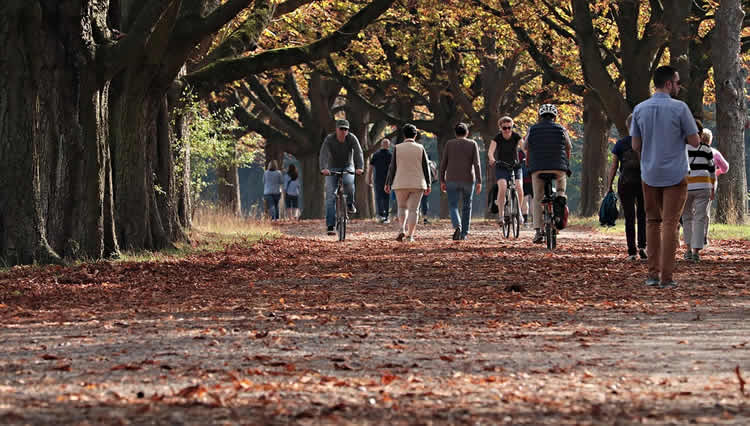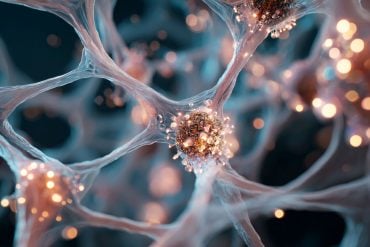Summary: Taking a ‘nature pill’ of spending twenty minutes a day outdoors can help to lower cortisol levels.
Source: Frontiers
Taking at least twenty minutes out of your day to stroll or sit in a place that makes you feel in contact with nature will significantly lower your stress hormone levels. That’s the finding of a study that has established for the first time the most effective dose of an urban nature experience. Healthcare practitioners can use this discovery, published in Frontiers in Psychology, to prescribe ‘nature-pills’ in the knowledge that they have a real measurable effect.
“We know that spending time in nature reduces stress, but until now it was unclear how much is enough, how often to do it, or even what kind of nature experience will benefit us,” says Dr. MaryCarol Hunter, an Associate Professor at the University of Michigan and lead author of this research. “Our study shows that for the greatest payoff, in terms of efficiently lowering levels of the stress hormone cortisol, you should spend 20 to 30 minutes sitting or walking in a place that provides you with a sense of nature.”
A free and natural stress-relieving remedy
Nature pills could be a low-cost solution to reduce the negative health impacts stemming from growing urbanization and indoor lifestyles dominated by screen viewing. To assist healthcare practitioners looking for evidence-based guidelines on what exactly to dispense, Hunter and her colleagues designed an experiment that would give a realistic estimate of an effective dose.
Over an 8-week period, participants were asked to take a nature pill with a duration of 10 minutes or more, at least 3 times a week. Levels of cortisol, a stress hormone, were measured from saliva samples taken before and after a nature pill, once every two weeks.
“Participants were free to choose the time of day, duration, and the place of their nature experience, which was defined as anywhere outside that in the opinion of the participant, made them feel like they’ve interacted with nature. There were a few constraints to minimize factors known to influence stress: take the nature pill in daylight, no aerobic exercise, and avoid the use of social media, internet, phone calls, conversations and reading,” Hunter explains.
She continues, “Building personal flexibility into the experiment, allowed us to identify the optimal duration of a nature pill, no matter when or where it is taken, and under the normal circumstances of modern life, with its unpredictability and hectic scheduling.”
To make allowances for busy lifestyles, while also providing meaningful results, the experimental design was novel in other aspects too.
“We accommodated day to day differences in a participant’s stress status by collecting four snapshots of cortisol change due to a nature pill,” says Hunter. “It also allowed us to identify and account for the impact of the ongoing, natural drop in cortisol level as the day goes on, making the estimate of effective duration more reliable.”
Nature will nurture
The data revealed that just a twenty-minute nature experience was enough to significantly reduce cortisol levels. But if you spent a little more time immersed in a nature experience, 20 to 30 minutes sitting or walking, cortisol levels dropped at their greatest rate. After that, additional de-stressing benefits continue to add up but at a slower rate.

“Healthcare practitioners can use our results as an evidence-based rule of thumb on what to put in a nature-pill prescription,” says Hunter. “It provides the first estimates of how nature experiences impact stress levels in the context of normal daily life. It breaks new ground by addressing some of the complexities of measuring an effective nature dose.”
Hunter hopes this study will form the basis of further research in this area.
“Our experimental approach can be used as a tool to assess how age, gender, seasonality, physical ability and culture influences the effectiveness of nature experiences on well-being. This will allow customized nature pill prescriptions, as well as a deeper insight on how to design cities and wellbeing programs for the public.”
Source:
Frontiers
Media Contacts:
Matt Prior – Frontiers
Image Source:
The image is in the public domain.
Original Research: Open access
“Urban Nature Experiences Reduce Stress in the Context of Daily Life Based on Salivary Biomarkers”
MaryCarol R. Hunter, Brenda W. Gillespie and Sophie Yu-Pu Chen Frontiers in Psychology (2019) doi:10.3389/fpsyg.2019.00722
Abstract
Urban Nature Experiences Reduce Stress in the Context of Daily Life Based on Salivary Biomarkers
Stress reduction through contact with nature is well established, but far less is known about the contribution of contact parameters – duration, frequency, and nature quality. This study describes the relationship between duration of a nature experience (NE), and changes in two physiological biomarkers of stress – salivary cortisol and alpha-amylase. It is the first study to employ long-term, repeated-measure assessment and the first evaluation wherein study participants are free to choose the time of day, duration, and the place of a NE in response to personal preference and changing daily schedules. During an 8-week study period, 36 urban dwellers were asked to have a NE, defined as spending time in an outdoor place that brings a sense of contact with nature, at least three times a week for a duration of 10 min or more. Their goal was compliance within the context of unpredictable opportunity for taking a nature pill. Participants provided saliva samples before and after a NE at four points over the study period. Before-NE samples established the diurnal trajectory of each stress indicator and these were in line with published outcomes of more closely controlled experiments. For salivary cortisol, an NE produced a 21.3%/hour drop beyond that of the hormone’s 11.7% diurnal drop. The efficiency of a nature pill per time expended was greatest between 20 and 30 min, after which benefits continued to accrue, but at a reduced rate. For salivary alpha-amylase, there was a 28.1%/h drop after adjusting for its diurnal rise of 3.5%/h, but only for participants that were least active sitting or sitting with some walking. Activity type did not influence cortisol response. The methods for this adaptive management study of nature-based restoration break new ground in addressing some complexities of measuring an effective nature dose in the context of normal daily life, while bypassing the limitations of a clinical pharmacology dose–response study. The results provide a validated starting point for healthcare practitioners prescribing a nature pill to those in their care. This line of inquiry is timely in light of expanding urbanization and rising healthcare costs.






